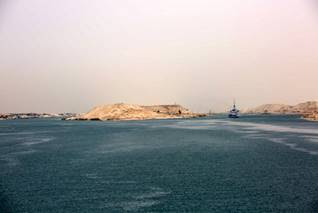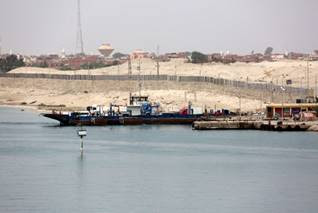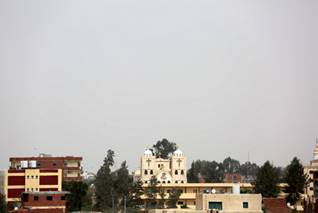Subject: Report # 99 Transiting the Suez Canal April 8, 2016 Friday Sunny & 79 degrees Part #1 of 2 86 Pictures
The Amsterdam transited the Suez Canal today. After cooling our heels last night outside the canal, we pulled the anchor, and began the transit sometime around or after 6am. As always, transit times are approximate and posted times are subject to change. There was live commentary, delivered by Location Guide, Barbara, but we have to say that it was by far way less than we had expected. Without any printed information on the Suez Canal, we were depending on a detailed transit, but it never came. Maybe we missed some of it during our dining room breakfast, but we were outside most all day, and heard just some of it.
Good thing we got the certificates later in the day, so here are some facts on this canal. It's nickname was "The Highway to India", and was made-made in 1869. It took 10 years to construct, connecting the Red Sea to the Mediterranean Sea. It allowed ship transportation between Europe and Asia without sailing around the Cape in Africa.
The canal begins from the Red Sea in Port Suez, with the city of Ismailia about the halfway point. The northern exit is at Port Said. After it was enlarged by 2010, the canal was 120.11 miles long, and 673 feet wide. The Great Bitter Lake is in the middle. Under the international treaty, the canal may be used in time of war and in peace by every vessel without distinction of flag. Of course, there is so much more history linked to this canal, but at the moment, this is all we have.
One nice part about today's transit are the Suez Rolls we got at breakfast in the dining room. Yitno, our muffin man, made sure he had some on his tray this morning. They had been served on the outside decks from 5:30 to 8am. But we did not intend to get up that early, mainly because we have done this transit more than once. Other nice touches today included strawberry smoothies and cold face towels outside at 10:30am. The pampering continued at 3:30pm with fruit skewers and more cold towels served on all outside decks.
For us, we spent most all day out on the bow, despite the heat. Early in the morning, it was not that bad, but later after lunch in the dining room with our buddies, it must have been somewhere near 90 or more degrees. Could have cooked an egg on the bow. Even the flies, knats, and ladybugs were gone…..too hot for them. We used insect repellant anyway to keep them away. It did work.
The scenery of this canal is far different from the Panama Canal. It is flat with no locks. It is well-guarded by the Egyptian military, who are also well-armed. Many guard houses and towers are present along the way, as well as mosques….such a contrast. There are a few cities, but the best scenery for us was the farmlands. Every farmhouse had bird towers, and although the traditional name eludes us, they are interesting to us. They are timeless, because they were used in ancient days to attract the wild flocks of pigeons. Built like a tee-pee, they are drilled with holes and perches. The birds have shelves for nest-building on the inside, and are happy to set up homes there. Now the farmers can harvest their eggs, have fresh squab occasionally, and make good use of the manure they create. The ancient Egyptians were "green" and they didn't even know it.
The lead ship today was an Egyptian warship, with the Amsterdam as the first ship leading the rest of the convoy. One of the ships behind us was the largest container ship in the world. Twice as long as us, and 15 meters wider, the ship was a behemoth. Staying nearer to the banks, many local fishermen were casting nets between their boats. Not sure if they were gill nets or shrimping nets. The fellows liked to come close and wave as we sailed slowly on by.
Most of the population was on the west banks, where we believe water from the Nile is delivered via canals and trenches. It keeps the trees alive, supplies drinking water, and allows for much agriculture. The areas surrounding the banks of the Nile are considered the breadbasket of Egypt. Consisting mostly of desert sand, these fields have been amended with fertilizers to make them rich growing grounds. When nothing is planted, the winds pick up this soil, and out it in the air. It creates a type of dust smog, that clouds the sun. Probably not the best thing to breathe. We see this in California's fertile agricultural valleys as well, during the dry time of year, especially in the autumn. It has been the culprit of what we call "valley fever", a type of lung disease that has flu-like symptoms. Don't know if that exists here, but we are certain it does.
We exited the canal by 4:30pm, when suddenly the temperature dropped at least 20 degrees. The waters of the Med were choppy, and the winds picked up significantly. Actually, it felt wonderful. We watched the Egyptian boat being off-loaded with the officials from the bow. Great timing to witness this. The other small boat had been dropped from the promenade deck, and off they went to the small harbor at Port Said. Captain Mercer beeped a goodbye to them, as they waved goodbye to all.
So much for our ports in Arabia, as now we are headed for several stops in Europe. It begins tomorrow with the port of Haifa, Israel.
Dinnertime was fun as always. All of us were there, so the table at the window was filled. It is referred to as the "kids" table now, while ten of us have the "big" table for the adults. Most times, none of us act like adults, which is why we have so much fun. Tonight for some unknown reason, we all whistled the tune to the Andy Griffin Show. All but Ruud, who is Dutch, and does not know the show from the USA. Our Aussie buddies, Greg, Heo, and Sharon covered their faces and denied knowing us, laughing the whole time. Who are the "kids" now?
Bill & Mary Ann
 One of the official's boats being loaded on the bow
One of the official's boats being loaded on the bow
 Communications towers in the canal
Communications towers in the canal
 Mary Ann checking out the boat
Mary Ann checking out the boat
 They string the nets between boats
They string the nets between boats
 The naval ship leads the convoy
The naval ship leads the convoy
 The skies were tinted with sand in the air
The skies were tinted with sand in the air
 More nets – might be gill nets
More nets – might be gill nets
 Heading out of the Bitter Lakes
Heading out of the Bitter Lakes
 The dredging is creating separate lanes
The dredging is creating separate lanes
 Pontoons can become a highway across the canal
Pontoons can become a highway across the canal
 Narrow passage for one way traffic
Narrow passage for one way traffic
 Getting too hot on the bow for most people
Getting too hot on the bow for most people
 Goes from one side to the opposite shore
Goes from one side to the opposite shore
 Many cars and people line up for the short ride
Many cars and people line up for the short ride
 One of the largest container ships in the world
One of the largest container ships in the world
 Halfway through the 120.11 mile canal
Halfway through the 120.11 mile canal
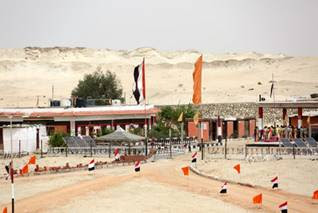 Located on both sides of the canal
Located on both sides of the canal
 Trucks, buses, and cars and walkers too
Trucks, buses, and cars and walkers too
 The laundry dries quickly here
The laundry dries quickly here
 Traditional Egyptian birdhouses
Traditional Egyptian birdhouses
 Even the apartments have the pigeon houses
Even the apartments have the pigeon houses
 Each hole has a perch for a bird
Each hole has a perch for a bird
 The pigeons lay eggs inside, where farmers collect them
The pigeons lay eggs inside, where farmers collect them
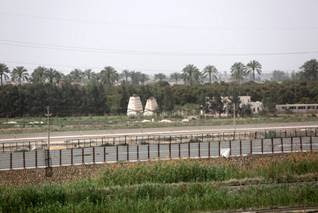 The bird manure is collected for the fields
The bird manure is collected for the fields
 Our escort disappears in the haze
Our escort disappears in the haze
 Still outside despite the heat
Still outside despite the heat
 Officials getting ready to leave
Officials getting ready to leave





















